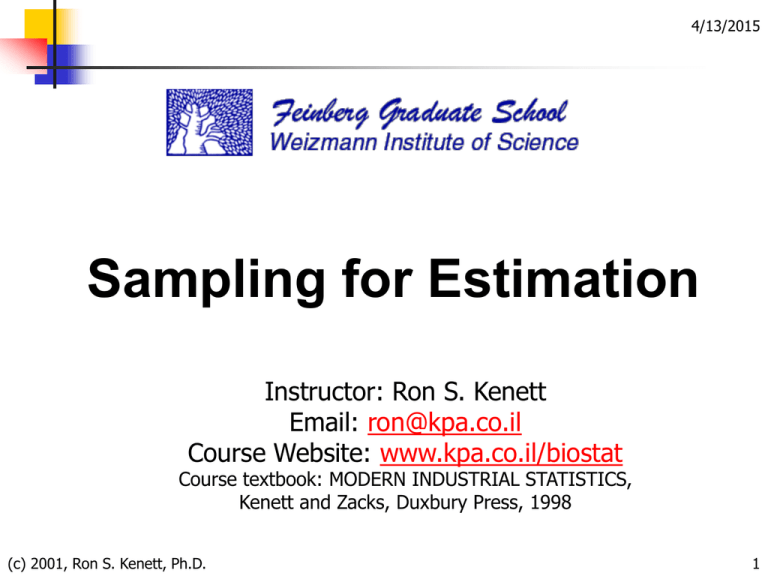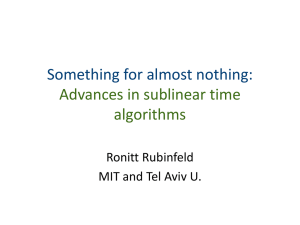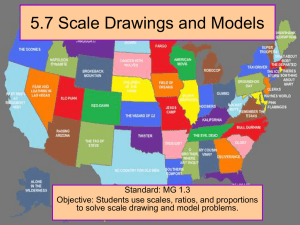Sampling for Estimation
advertisement

4/13/2015 Sampling for Estimation Instructor: Ron S. Kenett Email: ron@kpa.co.il Course Website: www.kpa.co.il/biostat Course textbook: MODERN INDUSTRIAL STATISTICS, Kenett and Zacks, Duxbury Press, 1998 (c) 2001, Ron S. Kenett, Ph.D. 1 4/13/2015 Course Syllabus •Understanding Variability •Variability in Several Dimensions •Basic Models of Probability •Sampling for Estimation of Population Quantities •Parametric Statistical Inference •Computer Intensive Techniques •Multiple Linear Regression •Statistical Process Control •Design of Experiments (c) 2001, Ron S. Kenett, Ph.D. 2 Key Terms Error Sampling Nonsampling of the mean of the proportion Standardized individual value sample mean Finite Population Correction (FPC) (c) 2001, Ron S. Kenett, Ph.D. Probability sample Standard error 4/13/2015 Simple random sample Systematic sample Stratified sample Cluster sample Nonprobability sample Convenience sample Quota sample Purposive sample Judgment sample 3 Key Terms Unbiased estimator Point estimates Interval estimates Interval limits Confidence coefficient (c) 2001, Ron S. Kenett, Ph.D. 4/13/2015 Confidence level Accuracy Degrees of freedom (df) Maximum likely sampling error 4 Types of Samples 4/13/2015 Probability, or Scientific, Samples: Each element to be sampled has a known (or calculable) chance of being selected. Simple random Systematic (c) 2001, Ron S. Kenett, Ph.D. Every person has an equal chance of being selected. Best when roster of the population exists. Randomly enter a stream of elements and sample every kth element. Best when elements are randomly ordered, no cyclic variation. 5 Types of Samples 4/13/2015 Probability, or Scientific, Samples: Each element to be sampled has a known (or calculable) chance of being selected. Stratified Cluster (c) 2001, Ron S. Kenett, Ph.D. Randomly sample elements from every layer, or stratum, of the population. Best when elements within strata are homogeneous. Randomly sample elements within some of the strata. Best when elements within strata are heterogeneous. 6 Types of Samples 4/13/2015 Nonprobability Samples: Not every element has a chance to be sampled. Selection process usually involves subjectivity. Convenience Quota (c) 2001, Ron S. Kenett, Ph.D. Elements are sampled because of ease and availability. Elements are sampled, but not randomly, from every layer, or stratum, of the population. 7 Types of Samples 4/13/2015 Nonprobability Samples: Not every element has a chance to be sampled. Selection process usually involves subjectivity. Purposive Judgment (c) 2001, Ron S. Kenett, Ph.D. Elements are sampled because they are atypical, not representative of the population. Elements are sampled because the researcher believes the members are representative of the population. 8 Distribution of the Mean 4/13/2015 When the population is normally distributed Shape: Regardless of sample size, the distribution of sample means will be normally distributed. Center: The mean of the distribution of sample means is the mean of the population. Sample size does not affect the center of the distribution. Spread: The standard deviation of the distribution of sample means, or the standard s . error, is s x = n (c) 2001, Ron S. Kenett, Ph.D. 9 The Standardized Mean 4/13/2015 The standardized z-score is how far above or below the sample mean is compared to the population mean in units of standard error. “How far above or below” sample mean minus µ “In units of standard error” divide by Standardized sample mean s n m sample mean = x –m z= s standard error n (c) 2001, Ron S. Kenett, Ph.D. 10 Distribution of the Mean 4/13/2015 When the population is not normally distributed Shape: When the sample size taken from such a population is sufficiently large, the distribution of its sample means will be approximately normally distributed regardless of the shape of the underlying population those samples are taken from. According to the Central Limit Theorem, the larger the sample size, the more normal the distribution of sample means becomes. (c) 2001, Ron S. Kenett, Ph.D. 11 Distribution of the Mean 4/13/2015 When the population is not normally distributed Center: The mean of the distribution of sample means is the mean of the population, µ. Sample size does not affect the center of the distribution. Spread: The standard deviation of the distribution of sample means, or the standard error, is s = s . x n (c) 2001, Ron S. Kenett, Ph.D. 12 Distribution of the Proportion 4/13/2015 When the sample statistic is generated by a count not a measurement, the proportion of successes in a sample of n trials is p, where Shape: Whenever both n p and n(1 – p) are greater than or equal to 5, the distribution of sample proportions will be approximately normally distributed. (c) 2001, Ron S. Kenett, Ph.D. 13 Distribution of the Proportion 4/13/2015 When the sample proportion of successes in a sample of n trials is p, Center: The center of the distribution of sample proportions is the center of the population, p. Spread: The standard deviation of the distribution of sample proportions, or the standard error, is s = p(׳1– p) . p n (c) 2001, Ron S. Kenett, Ph.D. 14 Distribution of the Proportion 4/13/2015 The standardized z-score is how far above or below the sample proportion is compared to the population proportion in units of standard error. “How far above or below” sample p – p “In units of standard error” divide by Standardized sample proportion z -p sample proportion = = standard error (c) 2001, Ron S. Kenett, Ph.D. s p = p(׳1n– p) p–p p(׳1– p) n 15 Finite Population Correction 4/13/2015 Finite Population Correction (FPC) Factor: FPC= N - n N -1 Rule of Thumb: Use FPC when n > 5%•N. Apply to: Standard errors of mean and proportion. (c) 2001, Ron S. Kenett, Ph.D. 16 Unbiased Point Estimates Population Parameter Sample Statistic Mean, µ s2 Variance, Proportion, (c) 2001, Ron S. Kenett, Ph.D. p 4/13/2015 x Formula x x = ni s2 (x – x)2 i s2 = p p = x successes n trials n –1 17 Confidence Intervals: µ, s Known where x = sample mean s = population standard deviation n = sample size z = standard normal score for area in tail = a/2 a/2 z: x: (c) 2001, Ron S. Kenett, Ph.D. ASSUMPTION: infinite population 1-a –z s ׳ x–z n 4/13/2015 0 x a/2 +z s ׳ + x z n 18 Confidence Intervals: µ, s Unknown where x = sample mean s = sample standard deviation n = sample size t = t-score for area in tail = a/2 df = n – 1 a/2 t: x: (c) 2001, Ron S. Kenett, Ph.D. ASSUMPTION: Population approximately normal and infinite 1-a –t x –t ׳s n 4/13/2015 0 x a/2 +t x +t ׳s n 19 Confidence Intervals on where p = sample proportion n = sample size ASSUMPTION: n•p > 5, z = standard normal score n•(1–p) > 5, for area in tail = a/2 a/2 p : p – z ׳p(1– p) (c) 2001, Ron S. Kenett, Ph.D. n p 4/13/2015 and population infinite 1-a p a/2 p + z ׳p(1– p) n 20 4/13/2015 Confidence Intervals for Finite Populations Mean: or x za s N – n 2 n N –1 Proportion: p za 2 p(1– p) N – n n N –1 s N – n x ta n N – 1 2 (c) 2001, Ron S. Kenett, Ph.D. 21 Interpretation of Confidence Intervals 4/13/2015 Repeated samples of size n taken from the same population will generate (1–a)% of the time a sample statistic that falls within the stated confidence interval. OR We can be (1–a)% confident that the population parameter falls within the stated confidence interval. (c) 2001, Ron S. Kenett, Ph.D. 22 Sample Size Determination for Infinite Populations 4/13/2015 Mean: Note s is known and e, the bound within which you want to estimate µ, is given. The interval half-width is e, also called the maximum likely error: e = z ׳s n Solving for n, we find: (c) 2001, Ron S. Kenett, Ph.D. 2 ׳s 2 z n= e2 23 Sample Size Determination for Finite Populations 4/13/2015 Mean: Note s is known and e, the bound within which you want to estimate µ, is given. 2 s n = e2 + s 2 N z2 where (c) 2001, Ron S. Kenett, Ph.D. n = required sample size N = population size z = z-score for (1–a)% confidence 24 Sample Size Determination of p for Infinite Populations 4/13/2015 Proportion: Note e, the bound within which you want to estimate p , is given. The interval half-width is e, also called the maximum likely error: e = z ׳p(1n– p) Solving for n, we find: (c) 2001, Ron S. Kenett, Ph.D. 2 p(1– p) z = n e2 25 Sample Size Determination of p for Finite Populations 4/13/2015 Mean: Note e, the bound within which you want to estimate p, is given. n = where p(1– p) + p(1– p) N e2 z2 n = required sample size N = population size z = z-score for (1–a)% confidence p = sample estimator of p (c) 2001, Ron S. Kenett, Ph.D. 26








